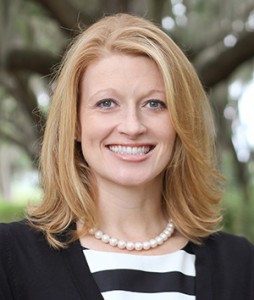
Staci serves as the legal advisor for Florida Farm Bureau Federation and its consolidated affiliates. Staci also serves as resource staff for all in-house legal matters, judicial and administrative issues, and endangered species and environmental issues.
Staci joined Florida Farm Bureau in 2009 as Director of Government and Community Affairs. Prior to joining Florida Farm Bureau, she served as a prosecutor for the Florida Department of Health, appearing before the Board of Medicine and Board of Nursing Home Administrators on disciplinary matters involving licensees.
Staci is a graduate of the University of Florida, Fredric G. Levin College of Law and a member of The Florida Bar. While in law school, Staci was selected as a Gubernatorial Fellow and worked on education policy for then-Governor Jeb Bush. Staci also holds a bachelor’s degree from the University of Florida, College of Agricultural and Life Sciences, in Food and Resource Economics, with a minor in Agricultural and Environmental Law and a minor in Management and Sales in Agribusiness.
Staci is a graduate of Class VIII of the Wedgworth Leadership Institute for Agriculture and Natural Resources and Class IX of the University of Florida Natural Resources Leadership Institute and can be reached at 352-384-2671 or staci.braswell@ffbf.org.
It’s a peninsula approximately 447 miles long and 361 miles wide, and is home to 33 first-magnitude springs — more than any state or any other nation in the world! There are 663 miles of coastline and over 11,000 miles of rivers, streams and waterways. Add to that 166 state parks, 3 national forests and one of only 11 National Scenic Trails. But that’s not all, this piece of paradise is also home to 19.3 million people and a thriving economy supported by international trade, tourism and agriculture. But there’s more, this unique landscape is also home to 90 endangered or threatened animals and 55 endangered or threatened plants.
Yes, it’s paradise — but many simply call it Florida.
The balancing act
It’s a delicate balance and constant juggling act to keep so many balls in the air — providing infrastructure and housing for Florida residents and guests, maintaining our spectacular water resources, sustaining and improving the state’s economy with industry, attractions and jobs, providing habitat for wildlife and producing the food, fiber and fuel we all need to survive.
Endangered and threatened species are an important part of the state’s unique ecosystem. Species loss in Florida is largely a consequence of population growth — which continues. Recent estimates project that population growth in Florida could exceed 21 million by 2020. How will we plan for such growth, while protecting our unique ecosystem and improving our state’s economy?
This big question is being addressed by several groups, including the Peninsular Florida Landscape Conservation Cooperative (PFLCC). PFLCC is made up of federal and state agencies, regional organizations, private stakeholders, universities and other entities within the state. This cooperative is designed to influence resource management decisions in an integral fashion across landscapes at a broader scale than any individual partner’s responsibility. The cooperative is considering landscape-scale stressors, including habitat fragmentation, invasive species and water scarcity as it attempts to provide a vision for a landscape capable of sustaining healthy populations of fish, wildlife and plants.
Agriculture’s important role in habitat protection
It has often been recognized that Florida farmers and ranchers not only provide food, fiber and fuel — but also provide green space and habitat for many of the state’s plant and wildlife species which are considered threatened or endangered. In fact, there are agricultural landowners who serve as recipient sites for species such as the gopher tortoise. A recipient site is private or public land which has been certified as a site to place gopher tortoises that are displaced by development. The objective of the recipient site program is to provide the highest level of long-term security for the gopher tortoise and its habitat.
But it’s not only endangered and threatened species that are of concern. Currently the Florida Fish and Wildlife Commission (FWC) is in the process of drafting 49 species action plans for 60 species, including the Florida sandhill crane. These species action plans will be part of the larger Imperiled Species Management Plan that addresses the commonalities of what’s necessary to conserve all wildlife represented in the plan. Florida Farm Bureau is following this process closely and is particularly interested in the Florida sandhill crane.
The Florida sandhill crane is a candidate for federal listing, but FWC officials believe the proposed conservation actions may preclude the need for that listing. One proposal in the plan is to work with ranchers, whose private lands are among the last strongholds of the species.
The Species Action Plan for the Florida sandhill crane states, “[m]ost private land used by cranes is managed for cattle ranching, sod farming, and other agriculture.” Farmers and ranchers have long considered themselves stewards of the land and are proud of the habitat protection they provide for wildlife species, including the Florida sandhill crane. With population growth continuing and the always present pressure to sell farm land for development, Florida Farm Bureau encourages utilizing viable economic landowner incentives that will allow these lands to remain in agricultural production while providing suitable habitat for all species.
It IS possible!
With the vision of groups such as the PFLCC, the determination of farmers and ranchers to continue to provide food, fiber, fuel and habitat, and continued education and outreach — it is possible!
We must work together to protect our state’s precious natural resources. Each plant and animal has a purpose. We must educate ourselves and reach out to our family, friends and neighbors to ensure future generations can enjoy these fantastic resources and this little piece of paradise many simply call Florida!

















